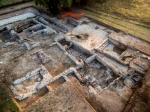Summary (English)
Excavation took place in the vast sectors north and south of the central rooms. At the same time specific interventions were undertaken in the eastern sector with the aim of exposing the two pools in the frigidarium.
Lastly, research on the road continued where a trench was opened in order to identify the phases preceding the construction of the basalt road.In the eastern sector of the building, the excavation of the northern pool of the frigidarium was completed. The floor surface was exposed, of which only the opus signinum make up was preserved with the negative traces of the marble slabs that formed its facing.
There was a partially preserved terracotta drainage tube in the pool’s south-western corner.The southern pool was then excavated. The fill was made up of a tile collapse from the room’s original roofing and a layer of polychrome figured wall plaster from the walls and ceiling. The removal of these layers revealed the pool’s marble facing.
A white marble head of a bearded Hercules, covered with a panther skin (max. width 0.12m; h. m 0.21 m) was found in the collapse.
Excavations continued in the area immediately west of the latrine (room P in the north-west sector of the baths). A new entrance to the baths from the basalt road delimiting the building to the north was identified by the presence of a local limestone threshold. Six new rooms were also identified (rooms Q, Z, Y, W, 1, 2) of which only one was completely excavated (Q).Room 2 was a corridor paved in opus spicatum; room 1 was not fully excavated in order to conserve the polychrome wall plaster that was still in situ; only the northern part of room W was excavated revealing a black and white mosaic floor with rhomboid and lozenge motifs; room Q a small rectangular anteroom provided a passageway from room W to the latrine, there were the remains of a white limestone mosaic and opus spicatum floor in its western part and clear traces of the robbing of a lead water pipe with multiple branches; lastly, the remains of a square well built of large fragments of local stone were uncovered in the north-eastern part of the small square room Z.
Excavation of the road continued towards the west for about a further 45 m. In this sector, the road showed several elongated cuts on a north-south alignment and other signs of later digging.
In antiquity, several basoli had been removed from the central part and this revealed the presence of a sewer under the road on an east-west alignment.
- Agnese Ugolini - Università del Salento, Dipartimento di Beni Culturali, Laboratorio di Topografia Antica e Fotogrammetria (LabTAF)
Director
- Giuseppe Ceraudo - Università del Salento, Dipartimento di Beni Culturali, Laboratorio di Topografia Antica e Fotogrammetria (LabTAF)
Team
- Agnese Ugolini, Valentino Vitale, Valentina Petrucci, Chiara Fernandez, Alessandra Albiero, Giovanni Murro
Research Body
- Università del Salento, Dipartimento di Beni Culturali
Funding Body
- Comune di Castrocielo






![Download [PDF]](/excavation/skins/fasti/images/results/download_sml.png)
